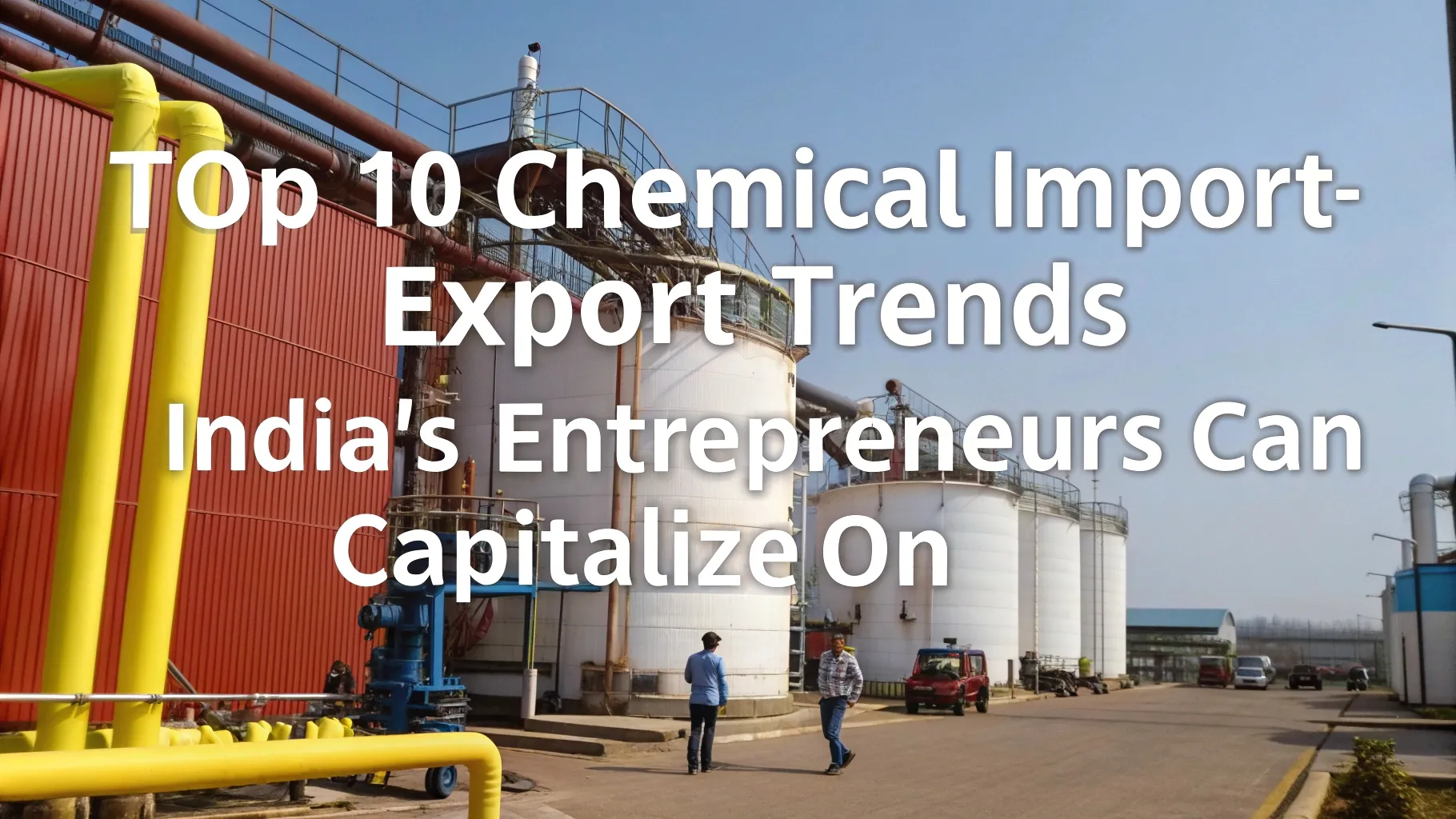India’s Strategic Chemical Trade Shift
India is quickly transforming into a significant player in international chemical trading. Chemical imports and exports have recently crossed the $37 billion mark, and are expected to reach $100 billion soon. The focus has now shifted from low-value bulk chemicals to high-value specialty chemicals, green chemistry, and meeting international standards. Government policies such as “Make in India” along with import-substitution-driven “real demand” are in place due to the growing double-digit export potential of agrochemicals, pharma intermediates, solvents, and specialty polymers.
The combination of increased global reliance on India after China + 1 strategy shift, high domestic demand, and low-cost technical and infrastructure support makes India a promising entry point for entrepreneurs and MSMEs in 2025. This article covers ten alluring trends in specific chemical products that serve as a strong foundation for import-export business for mid-sized companies.
This comprehensive guide aims to provide Indian entrepreneurs in the chemicals industry with actionable manufacturing and trade strategies to ensure their businesses are resilient to future challenges.
Related: Opportunities for Startups in India’s Chemicals Sector
1. Water Treatment Chemicals and Polymers
The importance of water treatment chemicals for industrial and municipal water processing is booming throughout Asia, Africa, and the Middle East. This is due to rapid urbanization, stricter discharge norms, rising concerns over water reuse, and the growing need for water. India is now a competitive exporter of polyacrylamides, flocculants, coagulants, and anti-foam products.
Building manufacturing units for these products requires polymer synthesis reactors, precise dosing control systems, and filtration units. Exporting requires quality standards like NSF and BIS certification. There is a growing market in Southeast Asia and Eastern Europe for economical highly purified water chemicals, and Indian companies are now supplying to those regions.
2. Bio-Based Solvents and Green Chemistry Products
The market for green solvents is booming, experiencing double-digit growth due to stricter regulations around VOC emissions and chemical toxicity. Indian entrepreneurs are already producing ethyl lactate, d-limonene, and bio-acetone from sugarcane and agro waste.
The production process is rooted in fermentation, distillation, and environmental compliant refinement. These green solvents support sustainable processes and offer significant growth potential in developed countries as coaters, ink, adhesive, and cleaning product manufacturers turn toward greener products. Startups partnering with biotech labs and using modular production systems for scalable and cost-effective solutions will capture emerging markets.
3. Export of Pharmaceutical Intermediates and Active Ingredients
India remains dominant in generic pharmaceuticals due to the robust supply of active pharmaceutical ingredients (APIs) and intermediates. Exports are transforming in 2025, shifting from bulk APIs to complex exports of intermediates for anti-infectives, anti-diabetics, oncology, and lifestyle diseases.
Manufacturing these intermediates requires complex processes including batch reactors with stringent purity standards and advanced quality control systems like HPLC, GC-MS, and residual solvent monitoring. Now, Western buyers prefer sourcing from India because of its adherence to cGMP and USFDA standards.
New entrepreneurs could target fermentation-based intermediates, derivatives from amino acids, or specialized excipients which are less competitive and offer higher profit margins.
4. Agrochemical Formulations and Technicals
India is now the global leader in formulating pesticides, particularly for herbicides and insecticides with low toxicity and biofungicides. The country’s existing regulatory framework, abundant raw materials, and established export history makes it an ideal candidate for new entrepreneurial ventures.
Agrochemical formulation requires emulsification, dispersion, granulation, or suspension of actives in carrier solvents or powders. The capital investment for the plant setup is not very high and there is scope for both in CDMO model partnerships and white-label exports.
There is a growing trend of Indian companies exporting to African and Latin American nations where low-cost and quality crop protection products are highly sought after.
5. Advanced Polymer Additives and Specialty Plastics
Additive manufacturing is being utilized in the medical field for packaging solutions, as well as for manufacturing construction materials for electric vehicles and electronics, which resulted in a massive boom for advanced polymers and specialty additives. Products like UV stabilizers, antistatic agents, flame retardants, and color masterbatches have also seen a sharp increase of over 10% CAGR.
Niche polymers such as polyphenylene sulfide (PPS), polyimides, and thermoplastic elastomers are exported from India too. Such entrepreneurs with formulation and compounding capabilities can take advantage of export-driven growth by setting up blending, pelletizing, and extruder-based units at moderate investment.
Export certification standards RoHS, REACH, and even FDA approvals are increasingly becoming mandatory.
Related: Acrylonitrile Butadiene Styrene(ABS) Market
6. Electrolyte Chemicals and Lithium-Related Intermediates
The push for EVs and grid-scale energy storage comes with a new wave of opportunity for battery materials India can export. Lithium hexafluorophosphate (LiPF6), lithium carbonate, and certain electrolyte solvents (EC, DEC) are in demand all over the world.
Production of these chemicals is expensive due to the need for dry room infrastructure, glove-box synthesis, and stringent quality control for moisture-sensitive intermediates. Most lithium refining is in China, but India has great potential for lithium refining with new manufacturing units in Gujarat and Rajasthan and raw stock material from other regions.
For new businesses, the optimal strategy would be penetrating the market as Tier-2 or Tier-3 suppliers to bigger cell manufacturers or engaging in low-volume, high-margin intermediate exports to Europe and Korea.
7. High-Purity Laboratory Reagents
The export of reagents for laboratories such as toluene, chloroform, acetone, nitric acid, and potassium permanganate has increased India’s export prominence as research and diagnostic laboratories seek alternative supply sources.
Preparation of such reagents involves several distillation and purification processes, pH balance, and reagent-grade bottling. Industries require a minimum purity of 99.9%, and the packaging should be made using certified HDPE or amber glass containers. With regards to reagents exports, packaging also includes safety data sheets (SDS), shippers, and other essential regulatory paperwork.
8. Biopesticides and Organic Plant Boosters
India is one of the top producers and exporters of biopesticides due to organic farming and zero-residue crop requirements emanating from the US and Europe. Trichoderma, Metarhizium, Beauveria, Bacillus, and neem emulsions are highly sought after these days.
Biopesticides production includes various processes from bio-fermentation and centrifugation to freeze-drying, formulation, and CFU (colony forming unit) validation. The niche is greatly appealing to startups because of its scalability. Biopesticides are well-suited for MSMEs that have access to bio-labs and agriculture partnerships because of strong export demand and relatively low initial investment.
9. Oil and Oil Derivatives From Plants
India has an abundant supply of palm, coconut, and castor oil, enabling the competitive production of oleochemicals such as fatty acids, esters, and glycerol derivatives. These oleochemicals find applications in cosmetics, food additives, as well as in lubricants and detergents.
The process steps encompass hydrolysis, esterification, methanolysis, and vacuum distillation. The global shift towards renewable, plant-based resources is positively impacting the Indian oleochemical industry, especially with increasing demand from Korean, Japanese, and European companies seeking clean-label products.
Entrepreneurs can either collaborate with soap manufacturers or set up small-scale distillation units to diversify and develop their products, thereby producing Chemical Import export-quality oleochemicals.
10. Construction Chemicals and Adhesive Systems
India’s exports of polyurethane sealants, epoxy systems, acrylic bonding agents, and waterproofing chemicals have grown rapidly. Global infrastructure investments in Middle Eastern, African, and Southeast Asian nations are driving this.
Manufacturing construction Chemical Import requires blending plants, polycondensation reactors, thickener mixing tanks, and filler dosing systems. With proper process controls and consistency in formulation, Indian units are producing competitive products that meet ASTM and DIN standards.
The best opportunities lie in exporting white-label formulations for tiling, concrete bonding, and waterproofing systems.
NPCS Support for Entrepreneurs Entering Chemical Trade
Building a globally compliant, profitable chemical Import business requires more than raw material access. Entrepreneurs need support on formulation design, manufacturing routes, plant layout, and market targeting.
This is where Niir Project Consultancy Services (NPCS) comes in:
- NPCS prepares Market Survey cum Detailed Techno Economic Feasibility Reports, which analyze both demand and competitive positioning across domestic and export segments.
- These reports include step-by-step manufacturing processes, raw material specifications, ideal plant layouts, and packaging standards.
- NPCS helps entrepreneurs evaluate the technical and market feasibility of chemical export businesses—helping reduce risks and improve time to market.
Conclusion: Riding the Export Wave in the Chemical Industry
The future of India’s chemical sector lies in high-value exports, Chemical import substitution, and next-gen formulation capabilities. As environmental and compliance regulations push the global chemical industry to reinvent itself, India is in the perfect position to become the chemical manufacturing and export hub for the 21st century.
By focusing on these top 10 Chemical Import-export trends and aligning operations with global quality standards, Indian startups and MSMEs can create lasting value in a highly profitable sector.






